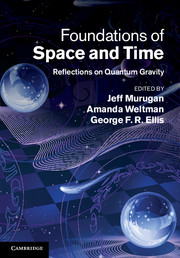Book contents
- Frontmatter
- Contents
- List of contributors
- 1 The problem with quantum gravity
- 2 A dialogue on the nature of gravity
- 3 Effective theories and modifications of gravity
- 4 The small-scale structure of spacetime
- 5 Ultraviolet divergences in supersymmetric theories
- 6 Cosmological quantum billiards
- 7 Progress in RNS string theory and pure spinors
- 8 Recent trends in superstring phenomenology
- 9 Emergent spacetime
- 10 Loop quantum gravity
- 11 Loop quantum gravity and cosmology
- 12 The microscopic dynamics of quantum space as a group field theory
- 13 Causal dynamical triangulations and the quest for quantum gravity
- 14 Proper time is stochastic time in 2D quantum gravity
- 15 Logic is to the quantum as geometry is to gravity
- 16 Causal sets: discreteness without symmetry breaking
- 17 The Big Bang, quantum gravity and black-hole information loss
- 18 Conversations in string theory
- Index
- References
10 - Loop quantum gravity
Published online by Cambridge University Press: 05 August 2012
- Frontmatter
- Contents
- List of contributors
- 1 The problem with quantum gravity
- 2 A dialogue on the nature of gravity
- 3 Effective theories and modifications of gravity
- 4 The small-scale structure of spacetime
- 5 Ultraviolet divergences in supersymmetric theories
- 6 Cosmological quantum billiards
- 7 Progress in RNS string theory and pure spinors
- 8 Recent trends in superstring phenomenology
- 9 Emergent spacetime
- 10 Loop quantum gravity
- 11 Loop quantum gravity and cosmology
- 12 The microscopic dynamics of quantum space as a group field theory
- 13 Causal dynamical triangulations and the quest for quantum gravity
- 14 Proper time is stochastic time in 2D quantum gravity
- 15 Logic is to the quantum as geometry is to gravity
- 16 Causal sets: discreteness without symmetry breaking
- 17 The Big Bang, quantum gravity and black-hole information loss
- 18 Conversations in string theory
- Index
- References
Summary
In this chapter we review the foundations and present status of loop quantum gravity. It is short and relatively non-technical, the emphasis is on the ideas, and the flavor of the techniques. In particular, we describe the kinematical quantization and the implementation of the Hamilton constraint, as well as the quantum theory of black hole horizons, semiclassical states, and matter propagation. Spin foam models and loop quantum cosmology are mentioned only in passing, as these will be covered in separate reviews to be published alongside this one.
Introduction
Loop quantum gravity is a non-perturbative approach to the quantum theory of gravity, in which no classical background metric is used. In particular, its starting point is not a linearized theory of gravity. As a consequence, while it still operates according to the rules of quantum field theory, the details are quite different from those for field theories that operate on a fixed classical background space-time. It has considerable successes to its credit, perhaps most notably a quantum theory of spatial geometry, in which quantities such as area and volume are quantized in units of the Planck length, and a calculation of black hole entropy for static and rotating, charged and neutral black holes. But there are also open questions, many of them surrounding the dynamics (“quantum Einstein equations”) of the theory.
In contrast to other approaches such as string theory, loop quantum gravity is rather modest in its aims. It is not attempting a grand unification, and hence is not based on an overarching symmetry principle, or some deep reformulation of the rules of quantum field theory. Rather, the goal is to quantize Einstein gravity in four dimensions. While, as we will explain, a certain amount of unification of the description of matter and gravity is achieved, in fact, the question of whether matter fields must have special properties to be consistently coupled to gravity in the framework of loop quantum gravity is one of the important open questions in loop quantum gravity.
- Type
- Chapter
- Information
- Foundations of Space and TimeReflections on Quantum Gravity, pp. 185 - 210Publisher: Cambridge University PressPrint publication year: 2012
References
- 2
- Cited by



